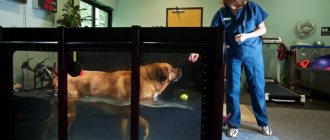Adenocarcinoma: brief characteristics and localization
The extent of the spread of glandular cancer is explained by the fact that the factors that provoke it surround the animal throughout its life. This is a special type of neoplasm that begins with a small, invisible focus, where the transformation of typical glandular tissue cells into pathological ones occurs. They give rise to atypicality in the next generation of cells, perpetuating the anomaly and then spreading very quickly. Moreover, even eliminating the provoking factor does not stop the growth of adenocarcinoma. Once it begins its pathological march through the body, it remains in it forever.
Localization of adenocarcinoma:
- endocrine glands (ovaries, adrenal glands, thyroid and parathyroid glands);
- exocrine glands (pancreas, intestines, salivary glands, prostate, stomach (internal ducts) and sweat, sebaceous, perianal, cerumin, mammary (external ducts)).
Important! Clinical studies of oncologists around the world, including humane (human) medicine, suggest that adenocarcinoma is the cause of death in pets in 50% of cases. It is almost impossible to prevent its development in advance; the breeder is unable to predict what exactly may provoke a violation of the division of glandular epithelial cells.
Prevention measures
There are no preventive measures against cancer as such. However, you can monitor the health of your pet. It is important to provide him with good, high-quality and balanced nutrition, a healthy lifestyle, timely treatment and excellent care.
To prevent cancer, you need to avoid risk factors, for example, not keeping your dog in direct sunlight. It has been proven that malignant melanoma occurs much more often with regular intense radiation, especially with sunburn.
Hairless and short-haired dogs are more susceptible to this than others, especially those with light skin and hair. White dogs and cats often have pink noses, which are very affected by the sun's rays. With repeated burns, the risk of cancer increases several times.
Although exposure to the sun is good for your animal's health, keeping it in direct sunlight is very dangerous. In hot countries, light-colored dogs should wear hats if they go out on the beach or on long walks. By the way, the local population has long been practicing such methods, supplying horses and donkeys with straw hats.
There are a number of studies that suggest that enriching food with vitamins and antioxidants reduces the risk of developing malignant tumors. In any case, you should always consult your veterinarian before taking any steps.
Diseases of the anus and rectum in dogs and cats are widespread. The causes, pathogenesis, diagnosis and treatment of these pathologies are considered.
Clinical signs of anal/rectal disease typically include constipation, dyschezia, and/or hematocesia. Conditions that typically involve the anus and rectum include anal sacculitis, perianal fistulas, perineal hernias, and proctitis. Occasionally, unusual granulomatous lesions or neuropathies/myopathies may be found affecting this area.
The main causes of constipation in dogs and cats include inadequate nutrition, pain after defecation (including musculoskeletal pain when trying to posture), intestinal obstruction, and colon weakness.
Diets that include indigestible substances (eg, plastic, sand) can be an important cause of constipation, especially in dogs with indiscriminate dietary habits.
Pain during defecation in dogs and cats can be caused by any degree of anal/rectal lesions (eg, anal sacculitis, proctitis, perianal fistulas, pelvic fractures, lumbosacral disease). The obstruction may be caused by stress (eg, carcinoma, pythiosis, congenital, scar) or a deviation of the colon lumen (eg, perineal hernia).
In dogs, hypothyroidism and hypercalcemia are recognized causes of colonic weakness, and in cats, idiopathic megacolon is the most common cause.
A good physical examination, including a digital rectal examination, is the first step in making a diagnosis - pelvic fractures, constrictions, anal sinus disease and perineal hernia in dogs and cats are all diagnoses from general practitioners that can be made without leaving the office.
This part of the physical examination is so important that doing a poor examination without chemical sedation is unacceptable. Trying to obtain a fecal sample to determine whether it is hard, contains inappropriate substances, or has a normal consistency is part of the rectal examination for the symptom of constipation in dogs.
It is important to note that it is easy to miss partial rectal strictures in large dogs. A 45 kg dog may have a stricture that reduces the anus by 75%, but which is not noticed when the doctor inserts one finger into the anus. If the history suggests rectal obstruction in a large dog, then it may be necessary to try inserting two (or in the case of people with small hands, three) fingers to see if the anus and rectum can dilate to normal diameter. Sometimes x-rays and endoscopy are necessary, but this is really unusual.
Dyschezia is caused by many of the same problems as constipation, and the approach is the same as for constipation.
Hematocesia in dogs and cats is a relatively common sign of anal/rectal disease, as well as colon pathology. Anal sacculitis and neoplasms (including benign polyps and mucosal-associated carcinomas) are the two most common causes of anal/rectal disease causing hematocesia.
Both should be diagnosed by rectal examination, although polyps may be very difficult to find in some dogs. Polyps are usually relatively soft and a quick digital examination may miss them or the doctor may think that it is just a fold of mucous membrane or some feces on the surface of the mucous membrane.
Spread of pathology
According to statistics, the death of more than half of all domestic small animals is due to malignant neoplasms. Adenocarcinoma is an age-dependent tumor and the explanation for its high mortality rate is that pet owners turn to the veterinarian too late, when glandular cancer has taken over more than 80% of the body.
Adenocarcinoma is diagnosed more often:
- in the mammary glands (in dogs per 100 thousand individuals, 100 cases/year);
- in the lungs (2-4 individuals per 100 thousand per year);
- in the gastrointestinal tract (10% of all malignant neoplasms).
Thus, veterinarians at the Ros-Vet VC have to deal with mammary gland tumors more often. Moreover, owners of females (dogs, cats) turn to a specialist already in the last stages of development of glandular cancer. Before this, trying to treat minor formations on my own.
Age criteria for adenocarcinoma:
- in the mammary glands, neoplasms are detected after 8 years;
- in the ovaries and prostate after 10 years;
- in the salivary glands and lungs after 10-12 years;
- in the perianal glands and stomach after 8-11 years;
- in the intestines after 6-9 years.
The earliest changes in glandular cells are observed in the intestines, perhaps due to the fact that the gastrointestinal tract is most exposed to negative factors. This could be low-quality food, poisons (in case of poisoning), bad water, carcinogenic substances coming from food or low-grade ready-made feed.
Therefore, it is advisable, starting from the age of 6, to bring pets for a preventive examination at the Ros-Vet EC. This way, adenocarcinoma can be identified in a timely manner, surgery can be performed, and the likelihood of rapid spread of pathological cells can be significantly reduced.
Blood cancer in dogs
Blood cancer in dogs, or leukemia, is a malignant pathology localized in the area of the lymphatic and hematopoietic system. Leukemia in its acute form is characterized by a severe course and rapid death. Blood cancer is an insidious pathology that has no clinical manifestations. The pet may be apathetic, appetite decreases, and the functioning of the digestive tract is disrupted. A sharp change in the size of the spleen leads to constipation, which is replaced by diarrhea. Symptoms of blood cancer in dogs during the transition to the acute stage are as follows:
- development of internal hemorrhages;
- weakness and anemia;
- changes in the blood picture - a sharp decrease in the number of red and white blood cells;
- spontaneous abortions in pregnant females.
Leukemia can also occur in a chronic form. In this case, the symptoms will differ. The animal suffers from severe thirst and frequent urge to urinate. Against the background of an enlarged spleen, constipation and diarrhea develop.
The acute form of blood cancer is the most dangerous. Due to the aggressive course, against the background of a general change in the condition of the body, the dog suffers from inflammatory processes on the skin, in the pulmonary structures and digestive tract.
Etiological factors
The reasons for the development of adenocarcinomas of various localizations may be “it is not known what.” It is this interpretation that most closely reflects reality. Unlike other tumors, it is impossible to accurately list the factors that in 100% of cases provoke changes in glandular cells.
Oncologists conditionally divide the causes of adenocarcinoma into:
- sporadic and familial;
- genetically determined (5-10% of cancer cases).
Moreover, when trying to systematize, it is impossible to unambiguously identify any special criteria that will reflect the specificity of the occurrence of adenocarcinomas.
The general picture can be drawn as follows: older animals, equally males and females, among dogs, breeds have been identified that are predisposed to glandular cancer of the mammary glands (see photo). Among the incidence of cancer of the apocrine paraanal glands, English cocker and springer spaniels, and King Charles spaniels are the leaders. The genetic pathway of adenocarcinoma has not been fully proven, although an association of cancer in spaniels with the leukocyte antigen DQB1 has been shown.
As hormonal factors, with changes in the functioning of the endocrine glands, cases of cancer development in the mammary and perianal glands have been identified. Proof of this version is the frequency of occurrence of the same type of tumor in individuals of the same sex (females, males) and the reaction of the tumor to hormone therapy.
Important! It has been proven that hormones in dogs play a large role in the development of tumors. If a female dog is spayed before her first heat, the risk of developing neoplasms in the future will be 0.5%. After the third heat, this figure increases to 26.8%. After 4 – in 100% of cases.
According to foreign studies, the risk of developing breast cancer in dogs increases with obesity, when feeding homemade food (red meat, little chicken), and not premium and super-premium industrial food. But it is worth noting that only high-quality (very expensive) ready-made feed can have a positive effect on animal health. Economy class, which is abundantly available on supermarket shelves, is not affected by this.
Behavior of adenocarcinoma in the body
It has been established that glandular cancer is aggressive; once it appears in an animal’s body, it invades new tissues, “adjusting” each time so as to capture as much as possible. Adenocarcinoma has a high metastatic effect, that is, metastases spread quickly and in large numbers.
Important! If there is an adenoma in the animal’s body, there is a possibility of its degeneration into adenocarcinoma. It has been proven that the presence of an adenomatous polyp in the rectum transforms into cancer in 18% of cases. Therefore, it makes sense to send a piece of a benign tumor for histology.
How does metastasis occur?
- lymphogenous route (to regional lymph nodes);
- hematogenous (through the blood to the nearest organs, most often the lungs and liver);
- implantation (into the body cavity, a typical sign of metastases in the lungs is effusion pleurisy).
To monitor the high metastatic potential, an animal with suspected adenocarcinoma must undergo an ultrasound of the internal organs and radiography. This way you can determine where the cancer has “crept” and how badly the internal organs are affected. It does not matter what size the adenocarcinoma is. Even a small “bump” on the surface can have a spreading network of metastases inside, affecting all internal organs.
Signs of development of intestinal lymphoma:
- lack of appetite;
- unusual drowsiness;
- rapid weight loss;
- swelling and enlargement of lymph nodes;
- periodic vomiting;
- diarrhea, presence of blood streaks in the stool;
- abdominal pain and bloating.
If any of these signs are observed, and even more so if they are combined, you need to invite a veterinary oncologist for an initial examination of the pet and the appointment of further diagnostics.
Basics of diagnosis
Without ultrasound and x-rays (skeletal metastases), it is impossible to get a complete picture of the disease. According to statistics, an animal enters the clinic with a 50-80% probability of having metastases. This means that a simple operation to remove a visible tumor is impossible; the result will not be justified, since vital organs are affected and the cancer will progress further.
First of all, regional lymph nodes (axillary, inguinal) are examined; it is in them that glandular cancer first grows. The presence of metastases in the lymph nodes makes it possible to predict the survival rate (on average 6 months, regardless of further treatment).
Treatment Options
In advanced cases, when an animal arrives at a veterinary clinic at stages 3-4 of adenocarcinoma, aggressive therapy is not justified. This is due not only to extensive metastasis of the tumor throughout the body, but also to disruption of the functioning of internal organs. In addition, a pet that has reached a respectable age (from 10 years old) is unlikely to easily undergo a serious operation. Therefore, it makes sense to support him symptomatically and let him live as long as he can, since with any type of treatment, glandular cancer in the final stages is not curable.
Chemotherapy for adenocarcinoma is not always justified and in practice shows a low level of effectiveness. Thus, systemic chemotherapy is not justified for gastric cancer in dogs. Some studies show that there are minor positive effects, but this does not indicate the possibility of curing adenocarcinoma.
Radiation therapy shows good treatment results, especially for nasal adenocarcinoma. But with prostate and ovarian cancer, it is not always necessary, since it affects the healthy organs of the abdominal cavity.
Diagnostics
At the appointment, the doctor carefully examines the patient and learns all the information about the course of the disease. Palpation of the abdominal wall can reveal large tumor formations. A strong pain reaction is possible due to rupture, trauma to the tumor, or the development of peritonitis.
Laboratory diagnostics includes a general clinical and biochemical blood test. Most often, anemia, leukocytosis, hypoproteinemia, and hypoglycemia are detected.
Contrast radiography can detect deformation, thickening of the intestinal wall, the appearance of ulcerative defects, abnormal position of intestinal loops, and narrowing of the intestinal lumen.
An abdominal ultrasound is also performed to identify the tumor process.
The most reliable diagnostic method is endoscopy. The procedure is performed under general anesthesia and requires certain preparation of the patient. Also, using an endoscope, you can take a piece of the tumor (biopsy) for further histological examination.
A chest radiograph is necessary to rule out pulmonary metastases.









